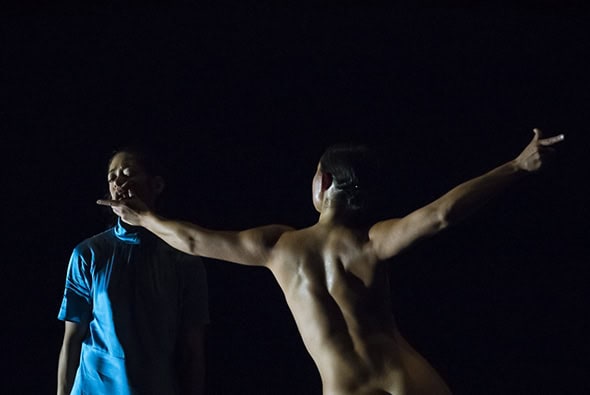Dance Umbrella 2019: Lucy Guerin’s Split at The Place
Posted: October 15th, 2019 | Author: Nicholas Minns & Caterina Albano | Filed under: Festival, Performance | Tags: Ashley McLennan, Dance Umbrella 2019, John Berger, Lilian Steiner, Lucy Guerin, Paul Lim, Scanner, Split | Comments Off on Dance Umbrella 2019: Lucy Guerin’s Split at The PlaceDance Umbrella 2019: Lucy Guerin’s Split at The Place, October 12

Lucy Guerin’s Split, performed by dancers Lilian Steiner and Ashley McLellan at The Place as part of Dance Umbrella, is an enquiry into duality that is structured on a grid laid down in white tape with a corresponding division of time. For the opening section, the dancers move within a spacious rectangle to a pulsing, driving score by Scanner for a prescribed period. When the time is up — and while the musical engine idles patiently — the dancers stop to rest, towel down and then divide the rectangle into two equal spaces with more white tape. They perform the next section in just one of the two rectangles for half the amount of time. With Paul Lim’s lighting providing an additional delineation to each section, the dancers continue in a diminishing geometric space/time structure until they have only a tiny square in which to stand and a final brief moment in which to resolve the entire choreographic puzzle. There is a strict logic to the pattern of partitions — resembling that of a Fibonacci series without the guiding Golden spiral — that appears to sublimate the agency of the dancers. Despite Guerin’s choreographic depiction of a ‘diminishing world’ that ‘induces competition, negotiation, harmony and aggression’, there is little overt emotional intent from the dancers beyond the gestural language itself.
In the first section, Steiner and McLellan perform an ever-expanding sequence of movements in unison, remaining in the same relation to each other without ever touching. The gestural expression extends out from the torso to the bodies’ extremities — especially the hands and fingers — as much as to the patterns on the floor. This harmonious relationship within an ample space can be seen as the ground of human identity, while the sheer volubility and intricacy of actions and reactions, of skipping, jumping, reclining and swirling in all directions — a tour de force for the dancers — shows the rich complexity of such ground. Within this apparent unity, Guerin introduces a singular contrast by choosing to clothe only one of her dancers. As she writes in the program, ‘Having one naked and the other clothed created a split in identity that intensified the piece. For me it gives seriousness and normality to the female body, which is such a site of commodification, exploitation, shame and shock.’ On the other hand, as John Berger wrote about the fine art tradition of the nude in Ways of Seeing, ‘She is not naked as she is. She is naked as the spectator sees her.’ While Guerin’s choice may provide an apt choreographic duality, in the context of the theatre she cannot preclude a spectator reaction that recognizes in Steiner’s naked body the very attributes she rightly deplores and allows their formal presentation to distract from the work’s rigorous construction. It is telling that the authority of Steiner’s body appears less assured than McLellan’s, suggesting she may not have come to terms with the reflection of her nakedness in the spectator’s gaze; she wears her nakedness like a costume but is not yet reconciled to revealing herself forcefully through it.
Given that Steiner remains as she is throughout Split, the polarity of naked and clothed becomes the guiding metaphor for other recognizable dualities Guerin develops — human/animal, coloniser/colonised, predator/prey, and master/slave — in subsequent sections that see an increasing inclination towards argument and examination, one memorably olfactory. Because McLellan is dressed, she comes across as the more dominant of the two women in images of aggression, while Steiner is inevitably seen as vulnerable. In their process of negotiation this works well, but when they swap antagonistic roles the duality is less convincing. Guerin’s structure and dramaturgy are most persuasive in showing that pressure from ever-diminishing space and time leads to ever-darker shades of behaviour. As Split develops, we see the individual increasingly at cross-purposes with herself — even if there are moments of respite and harmony — until Steiner’s enactment of disembowelling McLellan and eating her entrails suggests a profound existential crisis.
It is hard to read the final gesture in terms of all that has gone before. Reduced to a tiny space, there is only room for the two women to stand tightly together, with McLellan behind Steiner. As McLellan tips backwards the lights are quickly extinguished, leaving her fate suspended in space. As a powerful dramatic gesture — reminiscent of Tosca’s launch from the battlements in Puccini’s opera — it is beautifully timed and executed, but it leaves the issue of duality curiously unresolved.